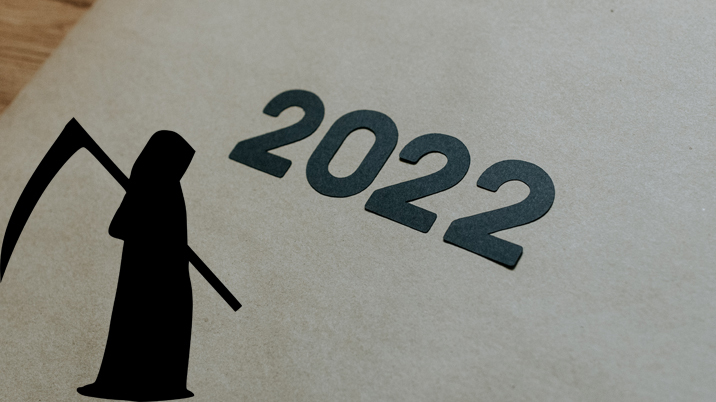
Welcome to 2023
The new year is supposed to be a time for fresh beginnings, the baby taking over from the old man. A time to look forward rather than to reflect and regret. So, I’ve been thinking about death. And looking backwards. Because I’m an awkward old woman.
I do believe that 2022 retrospectives should have been done and dusted by now, but my excuse is that the year had a week to run the last time we met – and it’s still not quite twelfth night – so maybe I can sneak one in before going into hiding for a few weeks.
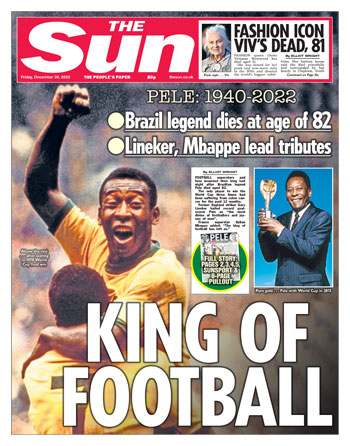
Thoughts of death were prompted by Pele, who naturally dominated every front page, some of them visually very good pages indeed.
Pele was an exceptional player and by all accounts a gracious man, the true GOAT as the Star put it – though I rather wish it had found a more elegant way to express the sentiment. It’s hard to imagine a sporting figure so deserving of the reverence and respect that poured forth on his demise.
The last such athlete I could think of was Muhammad Ali, probably the most famous man in the world in the 1970s. But even then, I’m not sure. In his prime, Ali divided opinion in the way Pele never did; in retirement he cut a sorrowful figure, diminished and ravaged by old age and disease, almost certainly brought about by his fighting career. (I really wish the Sun hadn’t published, let alone trumpeted, that “Ali at the end” picture shortly after his death in 2016. I’m not going to reproduce it here.)
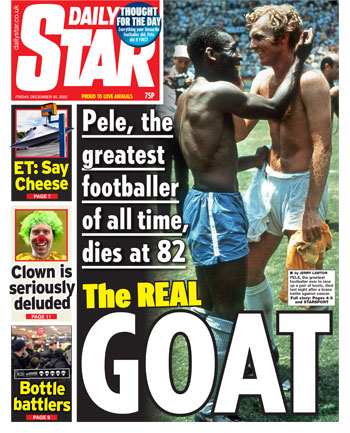
Pele, too, suffered ill health – colon cancer – in his later years, but he remained visible, an inspiration, in a way that had been impossible for Ali. There was also the proximity of the World Cup, the tournament that “belonged” to him, and the homage paid to him on the pitch by his compatriots. He was in our minds and then he was gone. Of course it was a big deal.
But this set me thinking about how our newspapers treat other deaths, the capricious nature of the way some people are given a whole tabloid front page or half the Guardian cover, while others who might in some eyes be seen as more notable, famous, popular or worthy are written off as a nib on page 4 with a cross-ref to the obits 80 pages back – or ignored altogether. I’m talking celebrity here; I’ll come to other deaths presently.
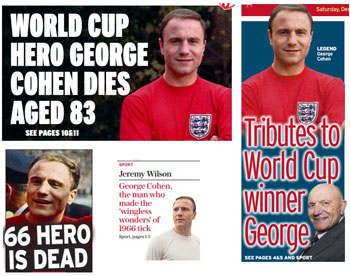
No one could more eloquently demonstrate the point I’m making than George Cohen, who died a few days before Pele. Of course he wasn’t in the same league as a player or as an international figure. But he was an actual England World Cup winner – and there have been only 11 of those in history. His death was well-covered in the sport sections, as you’d expect, and noted in most papers’ news pages, but his front-page presence was minimal. There were picture puffs in the Telegraph, Express, Mirror and Star and a text pointer in the i, but nothing on the covers of the Times, Sun, Mail or Guardian. Well it was Christmas Eve and a Saturday to boot. There were goodies to sell, festive feasts, telly listings, Robert Crampton wanting women to fancy him at 58. And the new king was going to give his first Christmas message. Such is fate. Maybe George should have clung on until a quiet Tuesday, ideally one when Kate wasn’t out and about, doing dress-wearing (more of that, too, presently).
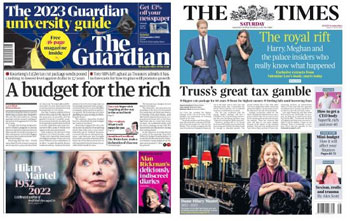
The same could be said of Hilary Mantel, who had a huge picture on the fronts of the Guardian and Times, but didn’t feature at all on the cover of the Telegraph. Well, her death was announced on the day of Kwasi Kwarteng’s disastrous budget, which sort of explains it. Except, as I noted here at the time, the Telegraph’s main picture was of the King sitting at a desk, which I’m sure you’ll agree is a totally unusual property and of far greater relevance to the paper’s readers. The other side of that coin is that, as I also noted here, the Telegraph did Barry Cryer proud with a wonderful main image back in January.
Then you have days when two people decide to go on the same day. As Dame Vivienne Westwood did with Pele. She was always going to lose that one – although the Sun and Mirror both very elegantly shoehorned her in beside the titlepiece on their poster fronts. In November, we saw a split between Leslie Phillips and the founding EastEnders actor, Bill Treacher. The Telegraph and Express naturally opted for Phillips, as did the Star and i; the Sun equally naturally highlighted Treacher, while the Mirror put them together as “lost legends”. Both were too lowbrow for the Guardian, Times and Mail.
As with all news judgments, several factors come into play in determining the coverage and the scale of it. That may sound obvious, but it’s interesting to note the various conventions different papers adopt: the Guardian tends to go for the classic “picture (often black and white), name, dates” format; the i frequently has “Tributes to xxx” in the two lines of “index” text it runs at the foot of the page. The Express almost always makes the story a picture puff.

Then there are the perceived interests of the readership (as we saw with Treacher and Phillips), whether there is something “newsy” about the death beyond who it is, and, of course, what else is going on that day. Most titles featured Meat Loaf prominently, but the fact of his dying from Covid was enough to promote him to the splash for the Mirror.
The Wanted singer Tom Parker was only 33 when he was killed by brain tumour, which gave the Star its lead, but the death interested only the redtops. At the other end of the age demographic, only the Telegraph promoted David Trimble, while the Express was alone in putting D-Day veteran Harry Billinge on the front. Dambuster Johnny Johnson fared a bit better.
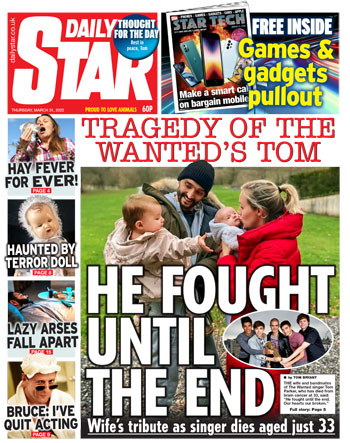
There were apparent perversities: The Times disregarded Jerry Lee Lewis and Meat Loaf, but put Ronnie Spector above the masthead and made Fleetwood Mac’s Christine McVie the main picture. The Guardian gave McVie the same treatment, but it was perhaps surprising to see her feature in the Star and Express puffs.
Apart from the Queen and Pele, only one celebrity death made every national newspaper front page (excluding the FT and Metro – which is handicapped by not publishing on a Saturday, when many of these demises were reported). Can you guess who?
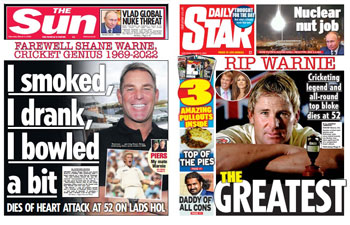
Of the other 15 most widely reported, only the Express scored a full house, while the Mail was the most ambivalent, trailing everyone else with only five: Shane Warne, Lester Piggott, Deborah James, Dennis Waterman and Angela Lansbury. Warne was the only one to make a splash for two papers – the Star and Sun (which both gave him precedence over the threat of global nuclear war). The Sun also led on James, June Brown, Waterman and Robbie Coltrane. The Star was alone in not putting “Dame Debs” on its cover, but it splashed Piggott, whom the Times alone ignored. As I say, horses for courses.
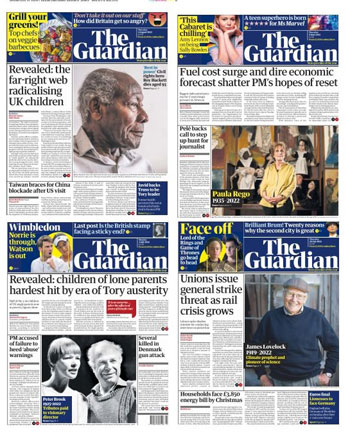
The Guardian kept Cryer and Coltrane inside, but more than made up for them with a clutch of front-page tributes, often as very big pictures, of people played down by everyone else. They included the civil rights campaigner Roy Hackett, the artist Paula Rego, the director Peter Brook and the scientist James Lovelock. The murder of the British journalist Dom Phillips in Brazil was, like Tom Parker, more than just “a death”, but again the Guardian was alone in thinking he mattered enough to put on page 1. My suspicion is it would have done so even had he not written for the paper. Jean-Luc Goddard might have seemed a more surprising “solo” effort for the paper – especially given that he went to Dignitas – but this was in the week before the Queen’s funeral, when even the Guardian gave half of its front to the hearse arriving at Buckingham Palace.
Ordinary people die too

So much for celebrities. Intriguing as all that is to some of us, there are deaths that should matter to all of us that are kept under the radar. The deaths of just six “ordinary” people made every front page, complete with picture: Elle Edwards and Olivia Pratt-Korbal, who were both shot dead by mistake in Liverpool, and the four boys who died after falling through ice in Solihull last month. The first two were truly alarming, both in the personal tragedies – in Olivia’s case, a girl of nine shot dead by an intruder in her own home – and in what they said about our society, so were clearly worthy of the press attention they received. The lads in the lake were equally obviously big news, given the number of victims and the desperate efforts to save them.
But isn’t it surprising that the Liverpool shootings were the only two killings to warrant universal front-page coverage? And even more so that only the Telegraph and the Sun thought another nine-year-old girl being stabbed to death while playing in the street with her sister was worth page one?

The Telegraph made Lilia Valutyte a big picture in her fairy outfit, the Sun a puff. The rest of Fleet Street – the high-minded Guardian among them – were far more captivated by the Wagatha Christie verdict and the Lionesses’ upcoming Euros final.
And that was it, as far as ordinary people in this country dying was concerned. Put them inside or ignore them altogether.
About 700 people are murdered in this country every year. At the beginning of last month, the Metropolitan Police said there had been more than 100 homicides in London in 2022. The website London World documents every teen killing in the capital; in 2021 there were 30, it has 14 so far for 2022. Since 2013, Karen Ingala-Smith has been “counting dead women” – women killed by men – and their names are read out in the Commons by Jess Phillips every International Women’s Day in March. At her latest update, the number for 2022 stood at 93, the previous year’s total was 144.
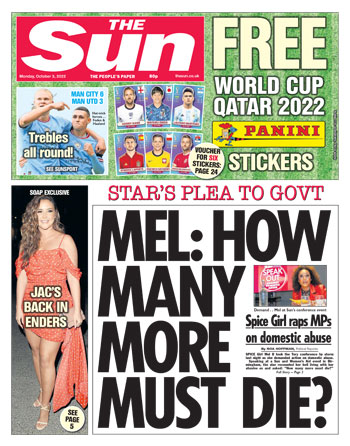
On October 3 last year, as the Tories gathered for their conference and Liz Truss was fighting for her political life, the Sun looked away from the big story consuming every other paper to focus on its own fringe event in Birmingham: the former Spice Girl Mel B calling for MPs to take action on domestic abuse.
There is a problem. The Sun, at least, recognises there is a problem – unless it is just caught up in its own self-promotion, which I doubt in this case (although it was a convenient diversion from the traumas of the party it supports).
I’m not suggesting that every killing should make the front, but if newspapers paid a bit more attention to cases that weren’t about children or pretty young white women and focused a bit more on the causes of lethal violence then, somewhere down the line, a life or two might be saved.
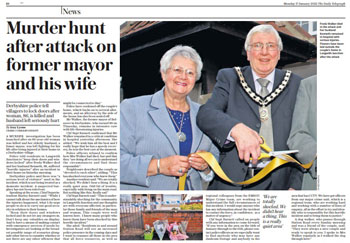
As it is, victims of domestic violence go virtually unregistered – unless they can be labelled as “honour killings”. We are far more interested in “stranger danger”. We like a hunt for a young woman, but beyond that, the Press generally waits for the perpetrators to be caught and put on trial before taking any real notice. As with the Telegraph and Freda and Kenneth Walker, a couple in their 80s who were tied up and beaten by a burglar at their home in Derbyshire last January. Mrs Walker died immediately, her husband – a former mayor – died of his injuries seven months later. The attack was reported on page 10. A little English girl killed by a speeding skier made a page 1 nib, an 86-year-old former mayoress bound and murdered in her own home did not. Such are the vagaries of news judgments; young lives are worth more than old, freak accidents are more interesting than burglaries that get out of hand. But come October, when a “Romanian national” was convicted of the killings, the case became worthy of a page one teaser – albeit with the full report again on page 10.
This is not a particular criticism of the Telegraph. No one else gave front-page space to either the attack or the verdict. After all, when Vasile Culea struck, the BBC licence fee was in question, Harry and Meghan were making life uncomfortable for the Queen with their latest complaints, Boris was making more promises of jam tomorrow. And when Culea was convicted, we’d just got our third prime minister of the year.
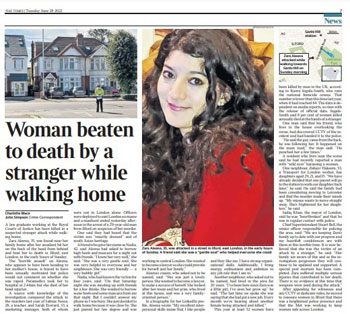
Then there was the case of Zara Aleena, who was stamped to death yards from her home in Ilford last summer. This would become a bigger story by the end of the year, but at the time, even this attractive woman didn’t trouble the front-page designers. Emma Raducanu was on court at Wimbledon and Johnson was making threatening noises at Putin. The killing made a page lead for the Times, the Guardian, Mail, Telegraph, Metro and Express, and a double column on a spread dominated by elephants in the Sun. But only 128 words as the smallest story at the bottom of page 7 in the Mirror, and just 69 words under the world’s fattest man dying on page 11 of the Star.
A man had been arrested – the angle preferred to the fact of the killing by the Guardian and Metro – so maybe the redtops had a sudden concern about contempt.
Or maybe not. Most were back for a second bite the next day, with friends paying tribute and so forth. Pretty wide coverage, given that the story was competing with Ghislaine Maxwell being sentenced and Deborah James dying. The Telegraph carried the jaw-dropping headline, “Law graduate beaten to death by stranger ignored friends who advised her not to walk back home”. Talk about victim-blaming. (And, actually, she didn’t walk home. She caught a bus and would have had to walk from the bus stop whatever happened.)
On the third day, she finally made a front page with a little piece in the Sun on her family saying “our Zara was so pure of heart”. There was more in the next few days about Ms Aleena’s love of walking and the importance of women being safe on the streets, comparisons with the cases of Sarah Everard and Sabina Nessa. She was also mentioned in the Tory leadership campaign.
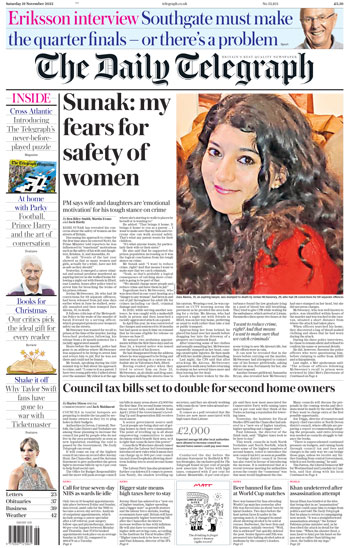
Fast forward to November and she is again on the front. This time as the Telegraph’s splash. Her killer had pleaded guilty and been sentenced the day before and now the prime minister had popped up to talk about his fears for the safety of women (he had previously written a column for the Mail about protecting women from sexual violence in July, but this had been tucked away on page 14).
It was an even better (if that’s the word) story than that: Jordan McSweeney had been released from jail on licence the week before the killing, but authorities had thought better of it, had revoked the decision, and were looking for him to recall to prison when he attacked Ms Aleena. CCTV footage presented to the Old Bailey by the prosecution also showed him stalking two other women before he finally pounced on Ms Aleena. The Times and Guardian made the case an early-ish right-hand page lead, the Mail – like the Telegraph angling the story on Rishi Sunak – had it on page 4, while the Mirror and the Sun put the fact of McSweeney being wanted by police at the top on page leads further back in the book.

Apart from the Telegraph, the Express made the most of it: a spread on 10 and 11 with a little red and white tag on the Daily Express crusade “Keep women safe on the streets”. It obviously feels strongly about the issue: it also ran a front-page picture puff, “Zara’s killer should have been in jail before attack”.
The splash that day was “It gets worse! Christmas turkey prices soaring”.

Meanwhile the football-averse Mail had “Fan fury as Qatar royals ban beer”, a “giant glossy World Cup wall chart” and Paddington Bear sliding down the banisters at Buckingham Palace.
The Mirror was similarly concerned about a dry World Cup, while everyone else was offering their special guides to the tournament. The Guardian was concerned about slave wages for security teams and the future of “brand Beckham”, and the Sun had the husband of an I’m a Celebrity winner being arrested after a birthday party brawl.
Food, drink, football, celebrity. Once we’ve sorted those, perhaps women’s and teenage boys’ lives will matter.
Oh, and by the way, the only celebrity other than the Queen and Pele to make every front page was Olivia Newton John.
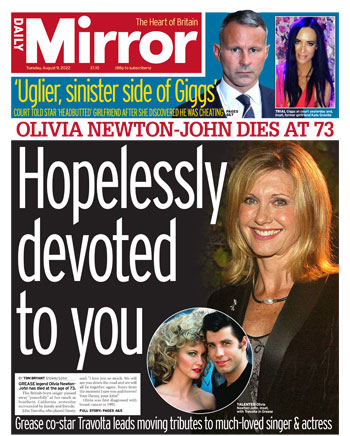
Thunderer turns messenger
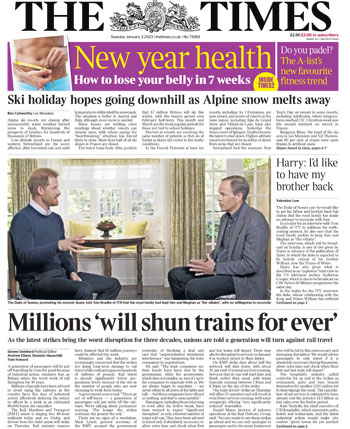
That Zara Aleena headline wasn’t the only one that stopped me in my tracks this week. Tuesday’s Times splash had the same effect: “Millions ‘will shun trains forever’”.
Even without further inspection it seemed nonsense. Millions? Really? Anyway, who says?
A ‘government source’. Right. The opinion of someone who won’t even put their name to their conclusion that a ‘generation of passengers will just write off the railways’ because of the current dispute is apparently regarded as such copper-bottomed fact that it is deemed worthy of the main story of what was once the world’s most respected newspaper.
I know, I know. Ninety per cent of political reporting is based on anonymous briefings. If we didn’t allow people to speak without attribution, we’d be denying our readers important information. But this isn’t whistle-blowing or even leaking. It is news management, propaganda, client journalism and it is a sorrow that the Thunderer should play this game.
It’s done it before, of course, but this seems a particularly grievous example of the paper becoming the messenger for one side of a two-sided conflict. And a messenger of misinformation and speculation at that.
I’ve banged on about the rail strikes before and the Press’s unwillingness to examine the issues at stake, the way the negotiations are being conducted and the government’s role in a dispute that is supposed to be between private companies and their workers. Most especially, the suggestions that, far from trying to resolve the conflict, ministers have actually blocked deals agreed between employers and unions.
The thing is, this attitude is showing the rightwing papers to be out of touch with their readers. Look at the independent polling: majorities of people questioned back most of the striking workers in the various industries. When the rail workers walked out again this week, TV news reporters from all channels were sent to stations to interview frustrated travellers. But instead of getting anti-union rants, they all got stoicism; passengers defending the people causing them inconvenience and their right to take action. Some editors might retort that the BBC, ITV, Sky, Channel 4 are all woke lefties that sought out the comments they wanted. Believe that if you wish, I don’t. Did every TV news editor edit out every anti-Lynch comment? Or every anti-RCN comment when they went to hospitals when nurses walked out?
But back to those “millions” who ministers “fear” will shun the railways for ever. Let me tell them they can sleep easy and calm their troubled minds. They won’t. Commuter trains have been unreliable, uncomfortable, overcrowded and overpriced for years and years. There has been plenty to put people off them, but they still use them. Mostly because they have to.
Passengers will find alternatives on strike days – as I did in the 1980s when Aslef staged regular walkouts in a dispute over “flexible rostering”. Then I would drive 40 miles to the nearest Tube; today I would simply work from home. But when the dispute is over, they will return, as I did. Because it’s inconvenient, time-consuming and expensive to drive into cities, where there are traffic jams, where parking is hard to find and extortionate, and where nowadays there are also (quite rightly) congestion and emission charges to deter car drivers.
Occasional rail travellers will delay their outings until things return to normal. But they’ll come back too. Because trains still have a magic, an off-peak journey can still be an experience to savour, particularly with the rather smart rolling stock that is coming into service on some lines now.
It really is time that reporters stopped soaking up and printing the rubbish dripped into their ears and started thinking for themselves, ignoring – or even better, calling out – the patently ridiculous. Maybe make a new year resolution to look further and serve readers the full stories rather than the ersatz preconceptions they are being asked to churn out?
Front page roll call
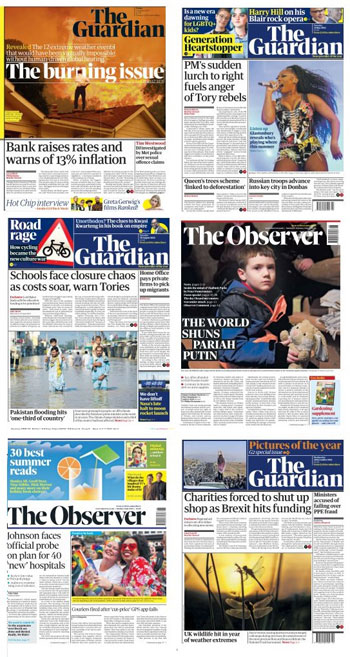
Well, all that talk of death in this week's notebook was a cheery start to the year, wasn’t it! Sorry.
Once you’ve started counting things, it’s hard to stop. And I’ve been counting pictures. Again.
It seems to me the front-page news spectrum gets ever narrower. There may be several reasons for this: having fewer staff and limited specialist resources, papers becoming increasingly agenda-driven, too much digital information on what engages readers so that editorial judgments are sacrificed to the algorithm, flight to “safe” or tried and tested subjects as audiences become harder to keep. Whatever, I think it’s detrimental to good journalism.
But where there might be an excuse for the restricted subject matter (I don’t think there is), I can see absolutely no justification for the extremely limited picture pool. The Guardian and Observer prove it doesn’t have to be like this. Like the redtops, they draw on their readers’ cultural preferences for material, and, like the redtops, that includes to a large degree television, sport and pop music. But they also embrace a far wider vision of the arts, plus science and – shock upon shock – actual news that might be happening in a country other than the UK. And more diversity. If you want to see non-white faces doing something other than being criminals, victims or cabinet ministers, look above or beside the redtop mastheads where the footballers live or in the Guardian or Observer. You’ll have to search hard to find anyone disabled anywhere.
This past year, we’ve had the war in Ukraine, which has forced everyone to broaden their horizons. We’ve had what might be described as a far bit of political upheaval, a lot of football, and the death of the Queen.
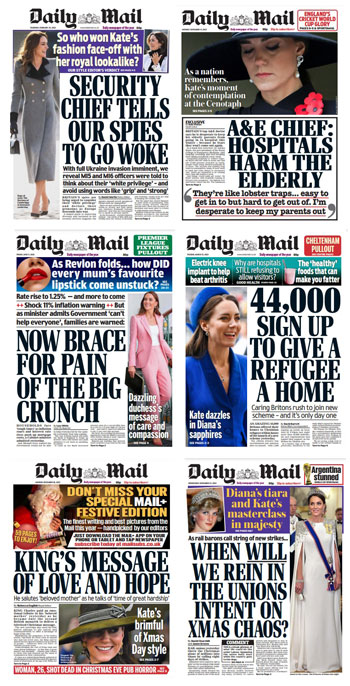
So guess who comes top of the front-page picture league, with an almost 30% lead ahead of her nearest rival? None of the above. It is, once again, the Princess of Wales, aka the Duchess of Cambridge.
Coming in at 325 appearances*, she beat the man who was PM for half the year into second place on 250, with her grandmother-in-law managing only third at 244. It comes to something when becoming the world’s longest-serving monarch, celebrating with a national platinum jubilee party, and then dying doesn’t get you ahead of a man brought down by a lack of integrity and a woman whose principal function in the eyes of the Press is to look good and be “caring”. To be fair, the late Queen would probably have stormed any league for the total number of pictures in national papers this year, but, surprisingly enough, I didn’t attempt to count those. What do you think I am? Some kind of masochist?
[*I looked at the Times, Telegraph, Guardian, Mail, Express, Sun and Mirror and their Sunday sisters. I discounted the Star and i because they have so many pictures, Metro because it publishes only Monday to Friday and the FT because it’s a world of its own.]

When it came down to it, I did a detailed count of fewer than 20 people, with only half of them unconnected to the royal family. There was no point in logging anyone else, though several, led by Coleen Rooney and Rebekah Vardy, made more than a dozen appearances. Adele, Ronaldo, Oti Mabuse were among them. For heaven’s sake, the royals-Tory politicos axis was so strong that Telegraph columnists Allison Pearson, David Frost and Allister Heath would all have seen off any interlopers trying to get into the top 20. Indeed, each of those three writers scored more appearances on the front of their paper than Keir Starmer (30) did in all newspapers put together – and his score was elevated only by the Mail’s “get him prosecuted for Beergate” campaign, the Mirror's loyalty and the party conference. They were hardly showstopping appearances – you might need a magnifying glass to spot him. Angela Rayner turned up about eight times, again with half of those courtesy of Beergate. Other Labour politicians didn’t get a look in.
Harry Kane (60) was the only other person to penetrate the gilded circle, though Ben Stokes and Beth Mead gave it a shot.
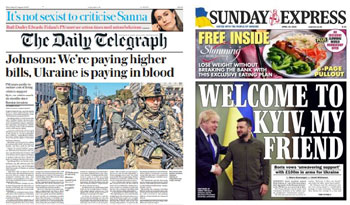
For the heck of it, I counted Putin and Zelensky and was dismayed to find that Putin (49) achieved almost double the Ukrainian president’s score – and Zelensky’s tally (27) would have been further diminished had he not generally been in the company of one B. Johnson Esq when he made it to our front pages. This is the man of the year, the man fighting to keep a mad bear at bay. Given the papers’ predilection for pointless drop-ins of people whose faces are more than familiar to us, how could he not score higher?
Because the reason the Johnson (and Putin) numbers are so high is this lazy design habit of throwing in a little cutout so poor readers don’t have to cope with grey text. The Mirror is particularly prey to this approach.
In the end, there were 1,361 pictures of the various royals on the 2,548 front pages of the titles I audited. So that means more than one every other page. It’s a lot. I’m not a republican, but I tend to think it’s too many. Andrew (100) was there mostly because he was a proper news story. I guess Meg (122) and Harry (142) were to a large extent a real story too, although the outrage about them was largely manufactured. William beat his dad by two (131-129), which seems a bit rich given that his father became King. Camilla (48) was beaten hands down by the Cambridge (sorry Wales) kids (68), but just about saw off “others”, who included not only Diana, Sophie and the York princesses, but also various actors in the Crown (46).
On the political front, Sunak reached 137, beating Truss (115) in this race at least. No one else came within a mile. Matt Hancock was closest on 45, entirely thanks to his antics in the jungle.
Of course these stalwarts are always going to win the race. The nature of news means that others are going to come and go like meteors. But it’s just the sheer scale of the dominance of the royals and the politicians that depresses me. Do we really need to see photographs of people whose faces are as familiar to us as our own families day in, day out? Especially those cut-outs and drop-ins that tell us absolutely nothing other than that the editors regard us as children who won’t read words without a picture to keep our attention.
I would love this year for there to be such a diverse and numerous collection of front-page subjects that counting them would be not only meaningless, but impossible.
Front page of the fortnight
The headline says it all:
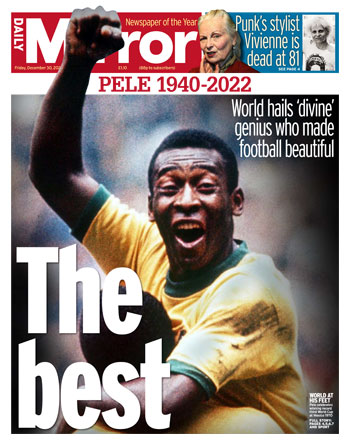
And now, you’ll be relieved to hear, I’ve run out of time. I want to look at papers’ special projects and at some of the great front pages of last year – there were a lot to admire. But it’s newsletter time, so I’m going to ask James if I can come back with part 2 of this retrospective next week.
Happy new year.
Liz Gerard’s Notebook is a fortnightly column published in the InPubWeekly newsletter. To be added to the mailing list, enter your email address here.












